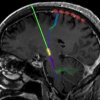Deep brain stimulation (DBS) can have dramatic benefits for people living with Parkinson’s disease, but how this technology actually works to influence the brain has remained a mystery. This is an issue because some patients respond much differently to DBS than others, so being able to tune the therapy to each patient can improve its effectiveness. Researchers at University of California, San Francisco have been experimenting with real Parkinson’s patients to identify the mode of action of DBS.
The team placed electrodes under the skulls of patients being implanted with DBS devices. They recorded the activity of the motor cortex, focusing on the “synchronicity” of the signals throughout the brain region. What they discovered is that in Parkinson’s patients there’s a high level of synchronicity, with large groups of neurons seemingly participating in a unified self-reinforcing rhythm. Yet, when deep brain stimulation was applied to the subthalamic nucleus, the synchronicity within the motor cortex dropped significantly, as though the neurons have decoupled themselves and are acting independently.
In the primary motor cortex of PD patients, neuronal population spiking is excessively synchronized to the phase of network oscillations. This manifests in brain surface recordings as exaggerated coupling between the phase of the beta rhythm and the amplitude of broadband activity. We show that acute therapeutic DBS reversibly reduces phase-amplitude interactions over a similar time course as that of the reduction in parkinsonian motor signs. We propose that DBS of the basal ganglia improves cortical function by alleviating excessive beta phase locking of motor cortex neurons.
Source:Nature Neuroscience
Scientists Explain How Deep Brain Stimulation Works in Parkinson’s Patients

